Il tuo messaggio è stato inviato.
Elaboreremo la vostra richiesta e vi ricontatteremo al più presto.
Il modulo è stato inviato con successo.
Ulteriori informazioni sono contenute nella vostra casella di posta elettronica.
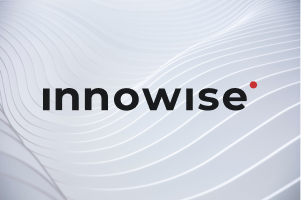
Selezionare la lingua
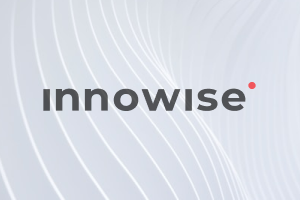

Avete mai lottato con progetti software che sforano costantemente il budget, non rispettano le scadenze o non soddisfano le aspettative degli utenti? Forse il vostro team ha faticato a definire i requisiti, oppure le responsabilità sono state frammentate, la comunicazione è stata lenta e i progressi si sono arenati. Non siete soli: queste sfide sono incredibilmente comuni, ma c'è un modo collaudato per affrontarle.
Questo è esattamente ciò che il SDLC (ciclo di vita dello sviluppo del software) è costruito per risolvere i problemi. Offre un approccio strutturato e ripetibile alla pianificazione, alla costruzione e alla consegna di un software che funziona davvero.
In questo articolo spiegherò cosa significa veramente SDLC oggi, come vi aiuta a chiarire il vostro processo fin dal primo giorno e come può aiutarvi a consegnare il software in modo coerente, più veloce e con molte meno sorprese.
Il ciclo di vita dello sviluppo del software (SDLC) è un percorso strutturato per i vostri progetti software, che suddivide processi complessi in fasi gestibili, dall'idea iniziale fino alla distribuzione e al supporto continuo. Ciascuna fase definisce compiti specifici, assegna ruoli chiari e stabilisce risultati tangibili, in modo che tutti i soggetti coinvolti siano in sintonia e sappiano qual è il loro compito.
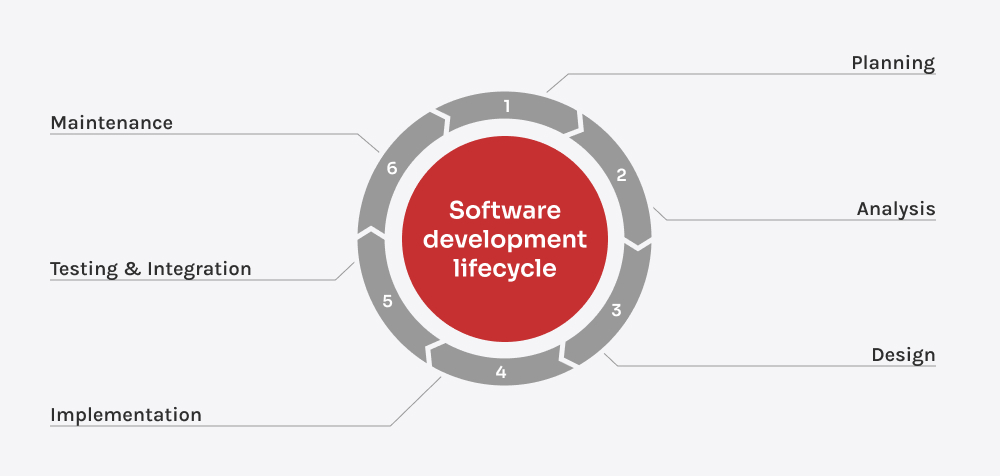
Il software non nasce in linea retta. Si evolve attraverso una serie di fasi SDLCintenzionali. L'SDLC guida questo viaggio, aiutando i team a rimanere allineati, a ridurre i rischi e a dare forma a prodotti che soddisfino effettivamente le esigenze degli utenti e del business.
È la fase del "perché lo stiamo facendo". È il momento in cui i team definiscono lo scopo, l'ambito, gli obiettivi, il budget e le scadenze del progetto. Gli analisti aziendali e i project manager lavorano a stretto contatto con gli stakeholder per identificare i punti dolenti e delineare una strategia di alto livello. Qui si svolgono colloqui con gli stakeholder, studi di fattibilità, valutazioni dei rischi e pianificazione delle risorse.
Una volta approvato il progetto, il team passa alla definizione di ciò che il software deve effettivamente fare. Il primo passo consiste nel raccogliere i contributi di tutte le parti interessate per comprendere le esigenze aziendali e le aspettative degli utenti. Questo porta alla documentazione dei requisiti funzionali (ciò che gli utenti devono essere in grado di fare) e dei requisiti tecnici (come il sistema deve comportarsi sotto il cofano). Nella fase finale, il team rivede e perfeziona i requisiti prima di procedere.
Nella fase di progettazione, il team trasforma i requisiti grezzi in un progetto pratico per la costruzione del software. Si inizia con la progettazione di alto livello, con la mappatura dell'architettura del sistema, dei moduli principali, del flusso di dati e del modo in cui le diverse parti interagiranno. Da qui si passa alla progettazione di basso livello, che descrive in dettaglio la logica, la struttura e il comportamento di ciascun componente, compresi i layout dei database e gli algoritmi chiave. Spesso i progettisti creano wireframe o prototipi cliccabili per esplorare il percorso dell'utente e individuare tempestivamente i problemi di usabilità. Questa fase elimina le congetture degli sviluppatori e aiuta a evitare costose rielaborazioni, facendo emergere le sfide tecniche prima che venga scritto il codice.
Nella fase di sviluppo, il software inizia a prendere forma quando gli sviluppatori traducono i progetti in codice funzionante. Costruiscono l'applicazione pezzo per pezzo, spesso in cicli brevi e mirati che consentono test, feedback e aggiustamenti frequenti. Gli sviluppatori non si limitano a scrivere il codice, ma compiono scelte architettoniche deliberate e strutturano le funzionalità in modo da garantire la manutenibilità a lungo termine. Durante tutto il processo, gli sviluppatori rimangono in stretta sintonia, rivedendo il lavoro dell'altro, affinando la logica e risolvendo i problemi in modo collaborativo per mantenere il prodotto allineato alla visione tecnica e agli obiettivi aziendali.
A prescindere dalla qualità del codice, un software non testato è una bomba a orologeria. La fase di collaudo è quella in cui il prodotto viene sottoposto a test prima di raggiungere gli utenti. In genere inizia con il test di sistema, per verificare se l'intera applicazione funziona come un'unità. Poi si passa ai test manuali, in cui gli ingegneri QA simulano l'uso reale e i casi limite. Infine, i test automatizzati intervengono per coprire le attività ripetitive su scala, garantendo la stabilità dopo ogni nuova distribuzione.
La distribuzione è il momento in cui il software lascia il laboratorio ed entra nel mondo reale. Il team distribuisce il prodotto agli utenti - in un unico grande lancio o gradualmente attraverso rilasci scaglionati - monitorando attentamente il suo comportamento nell'ambiente reale. Questa fase comporta la configurazione dell'infrastruttura, l'impostazione di pipeline di distribuzione automatizzate e la preparazione di strategie di rollback nel caso in cui qualcosa vada storto. Sviluppatori, ingegneri DevOps e QA lavorano spesso fianco a fianco per facilitare il processo di rilascio, risolvere i problemi dell'ultimo minuto e assicurarsi che tutto funzioni esattamente come previsto fin dal primo giorno.
Una volta che il software è operativo, inizia il vero test. Il team monitora le prestazioni, risponde ai feedback degli utenti e affronta i bug o le vulnerabilità che emergono in condizioni reali. Altrettanto importante è che i team di supporto lavorino in prima linea, raccogliendo informazioni dagli utenti, mentre gli sviluppatori si occupano delle modifiche tecniche e dei miglioramenti a lungo termine. Il software diventa così un prodotto vivo, costantemente perfezionato per rimanere attuale e affidabile.
Il modo in cui si costruisce il software è importante tanto quanto il prodotto che si sta sviluppando. I modelli SDLC danno struttura al caos, aiutando i team a gestire obiettivi mutevoli, scadenze strette e il costante braccio di ferro tra qualità e velocità.
Il modello Waterfall è un approccio lineare e sequenziale. Si compone di fasi distinte: Requisiti, Progettazione, Implementazione, Test, Implementazione e Manutenzione. Ogni fase deve essere completata prima di passare alla successiva. Una volta terminata una fase, non si può tornare indietro. Questo modello funziona bene quando i requisiti sono ben definiti ed è improbabile che cambino.
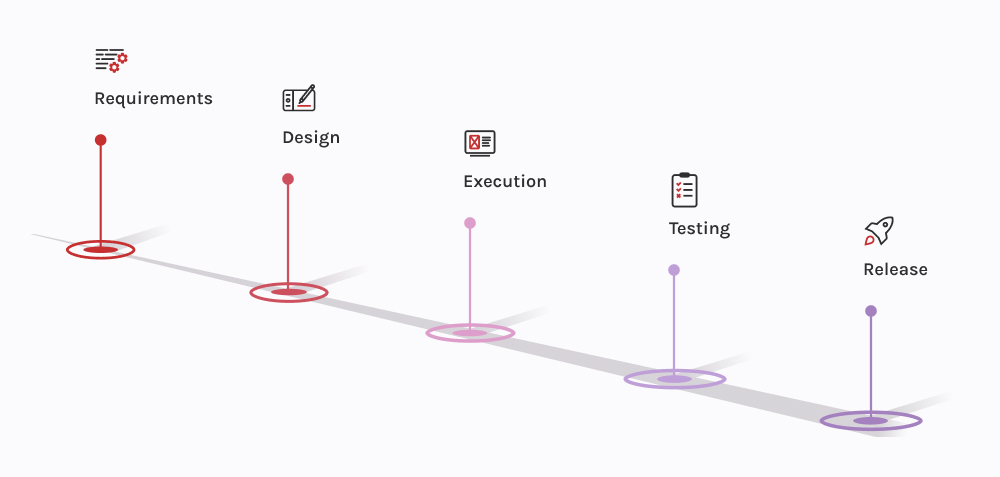
Il modello Agile divide il progetto in parti piccole e gestibili, chiamate sprint, che di solito durano 2-4 settimane. Durante ogni sprint, i team sviluppano, testano e raccolgono feedback per apportare miglioramenti. L'Agile enfatizza la collaborazione con il cliente e la flessibilità, consentendo modifiche anche in fase avanzata di sviluppo. I framework Agile più diffusi sono Scrum e Kanban. È ideale per i progetti in cui i requisiti cambiano frequentemente, come i software con aggiornamenti regolari.
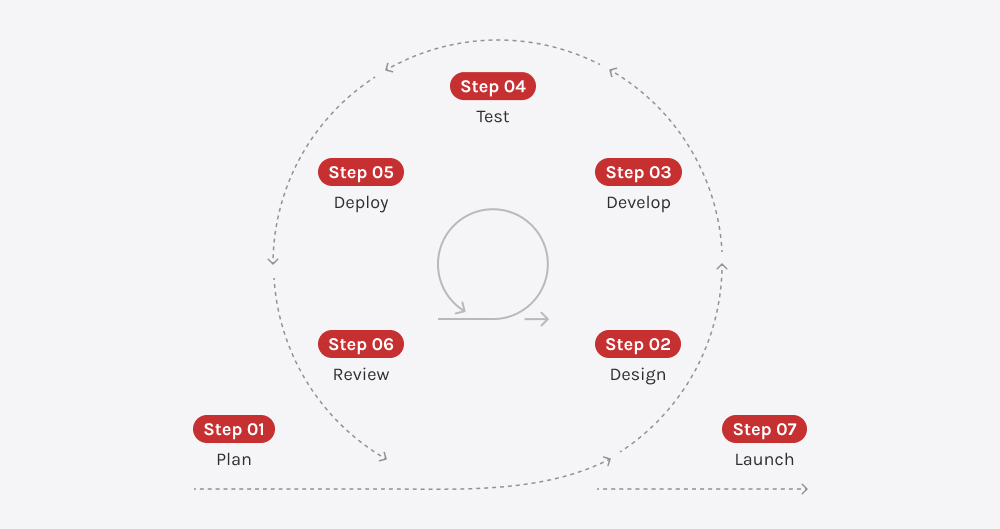
Il modello iterativo consente di costruire il software passo dopo passo. Si inizia con una versione semplice del prodotto, poi si continua a migliorarla attraverso più iterazioni. A ogni iterazione, il team pianifica, progetta, codifica e testa nuove funzionalità o perfezionamenti. È una scelta solida quando l'ambito del progetto non è completamente definito all'inizio, perché si può adattare e migliorare man mano che si procede.

Il modello a spirale combina lo sviluppo iterativo con la valutazione sistematica dei rischi. Si compone di quattro fasi principali: Pianificazione, Analisi del rischio, Progettazione e Valutazione. Ogni ciclo della spirale affronta una serie di requisiti, con una valutazione del rischio in ogni fase. Il modello ripete il processo, aggiungendo gradualmente altre funzionalità. Si usa per progetti grandi, complessi o ad alto rischio, come i sistemi software aerospaziali o critici.
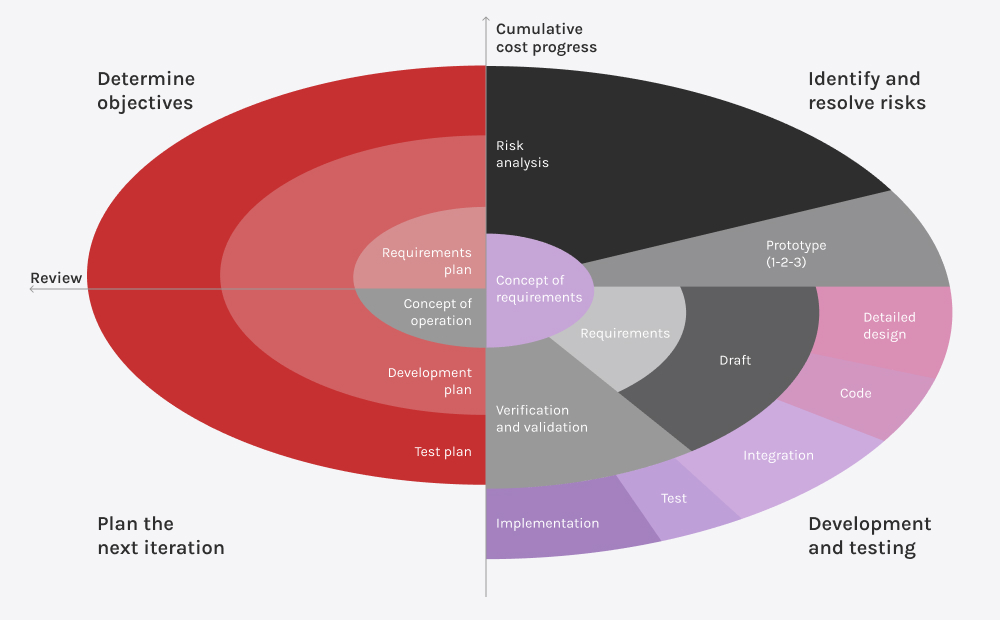
Questo modello è simile a quello Waterfall, ma integra test approfonditi in ogni fase. Dopo aver completato una fase di sviluppo, segue una corrispondente fase di test. Ciò lo rende più affidabile per i progetti in cui l'accuratezza e la convalida sono fondamentali.
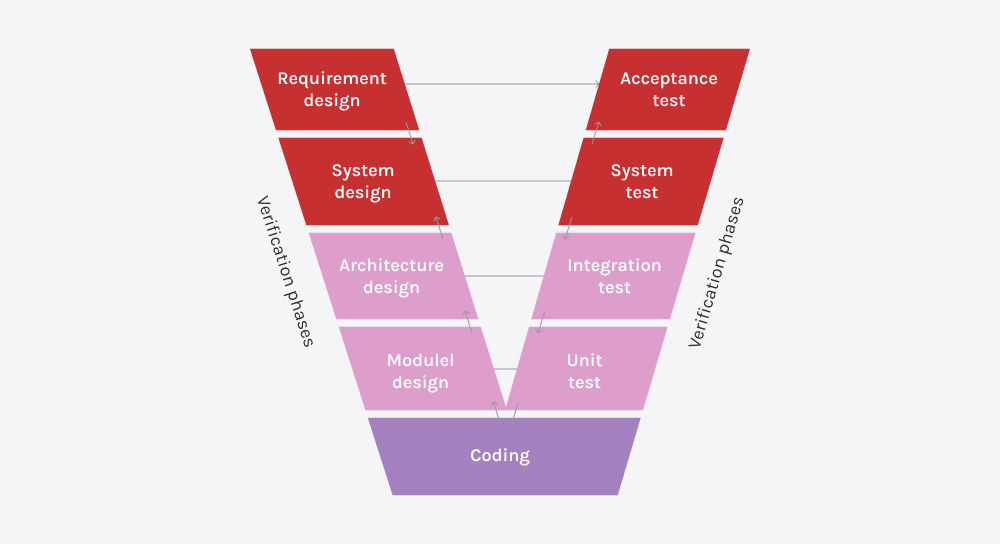
Il modello Big Bang prevede l'avvio dello sviluppo senza una grande pianificazione. Gli sviluppatori creano il software sulla base di requisiti limitati, spesso puntando a un prototipo rapido. Questo modello è ad alto rischio e può portare a risultati imprevedibili, ma è adatto a piccoli progetti con requisiti semplici o a software sperimentali.
Il DevOps è un approccio che combina lo sviluppo del software (Dev) e le operazioni IT (Ops) per migliorare la collaborazione, la velocità e l'efficienza. Si concentra sull'automazione di attività ripetitive come test, integrazione, distribuzione e monitoraggio.

Scegliere il giusto modello SDLC può dare il tono all'intero progetto. Non si tratta di un modello unico: la scelta del più adatto dipende da fattori quali le dimensioni del progetto, la complessità, il budget, le scadenze, l'esperienza del team e il coinvolgimento delle parti interessate.
Vediamo come abbinare le diverse metodologie SDLC alle caratteristiche tipiche del progetto:
| Fattore | Modelli SDLC consigliati |
| Requisiti chiari | Cascata, modello a V |
| Cambiamento dei requisiti | Agile, iterativo |
| Piccoli progetti | Waterfall |
| Progetti grandi o complessi | Agile, a spirale, DevOps |
| Interazione frequente con i clienti | Agile, Scrum |
| Interazione minima con il cliente | Cascata, modello a V |
| Budget e tempistica fissi | Cascata, modello a V |
| Budget e tempistiche flessibili | Agile, a spirale |
| Sono necessari sganci rapidi | Agile |
| Tempi di sviluppo più lunghi | Cascata, modello a V |
| Manutenzione continua | Agile, DevOps |
L'adozione di un approccio basato sul ciclo di vita dello sviluppo del software (SDLC) può davvero cambiare l'andamento dei vostri progetti software. Ecco come l'SDLC contribuisce a rendere l'intero processo più gestibile ed efficace:
Innowise ha potuto constatare di persona come il software ciclo di vita dello sviluppo (SDLC) semplifica la vita ai nostri team e ai nostri clienti. Seguendo le best practice dell'SDLC, siamo in sintonia con tutti i soggetti coinvolti, definendo chiaramente obiettivi e aspettative fin dall'inizio. Questo significa meno sorprese, processi più fluidi e risultati prevedibili in ogni fase, dalla pianificazione allo sviluppo, fino al collaudo e alla distribuzione.
Pensate di aggiornare il vostro approccio? Date un'occhiata alla nostra pagina dei servizi e vedete come possiamo aiutarvi a portare chiarezza ed efficienza al vostro prossimo progetto software.
Dmitry è a capo della strategia tecnologica alla base di soluzioni personalizzate che funzionano davvero per i clienti, ora e durante la loro crescita. Unisce la visione di insieme all'esecuzione pratica, assicurandosi che ogni progetto sia intelligente, scalabile e in linea con l'azienda.
Valuta questo articolo:
4.8/5 (45 recensioni)







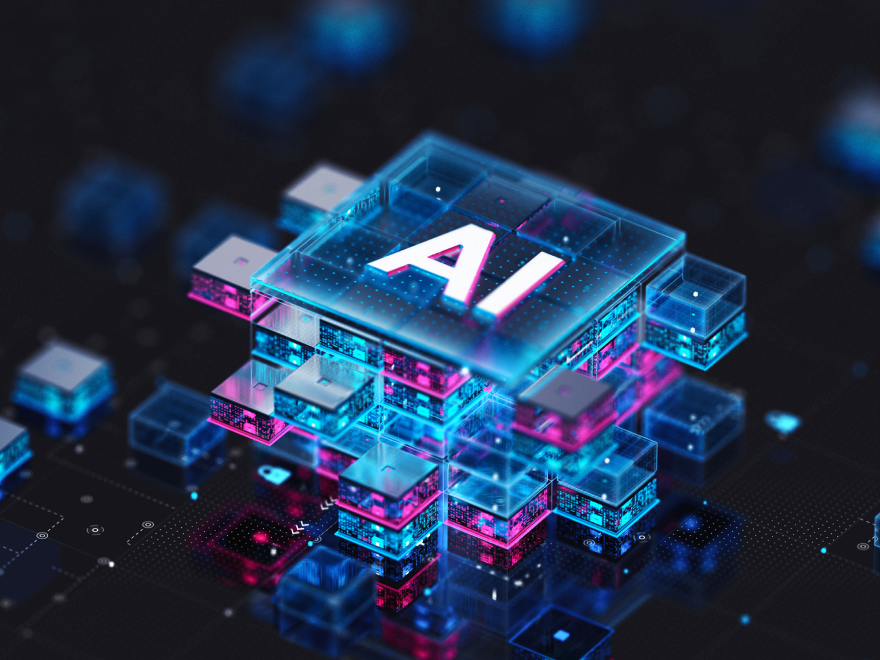




Il tuo messaggio è stato inviato.
Elaboreremo la vostra richiesta e vi ricontatteremo al più presto.

Iscrivendosi si accetta il nostro Informativa sulla privacy, compreso l'uso dei cookie e il trasferimento dei vostri dati personali.